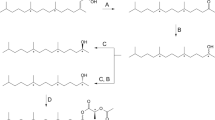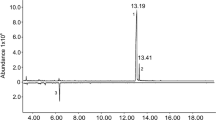Abstract
Although aphids reproduce asexually on their host plants during the summer, many species migrate to a winter host where sexual reproduction occurs. Males of certain species locate mates by means of a sex attractant pheromone released from the hind legs of the females1–4. Here we report the identification of such a pheromone from the vetch aphid Megoura viciae. Extracts of the excised legs of sexual females were analysed by gas chromatography-coupled single cell recording techniques (GC-SCR)5 and by gas chromatography-coupled mass spectrometry (GC-MS). A tentative identification by MS analysis of the two active components as specific isomers of the monoterpenoids nepetalactone (I), a known cat attractant, and nepetalactol (II) was confirmed by comparison with authenticated compounds isolated or synthesized from natural products. Although neither compound was attractive to males when presented alone in the laboratory bioassay, a mixture of the two components produced a response equal to that elicited by the female leg extract. Thus the sex pheromone of M. viciae comprises a synergistic mixture of the nepetalactone I and the nepetalactol II. The identification of aphid sex pheromones will provide a further means of investigating and manipulating the behaviour of these ubiquitous pests.
This is a preview of subscription content, access via your institution
Access options
Subscribe to this journal
Receive 51 print issues and online access
$199.00 per year
only $3.90 per issue
Buy this article
- Purchase on Springer Link
- Instant access to full article PDF
Prices may be subject to local taxes which are calculated during checkout
Similar content being viewed by others
References
Petterson, J. Entomol. Scand. 1, 63–73 (1970).
Petterson, J. Entomol. Scand. 2, 81–93 (1971).
Marsh, D. Nature new Biol. 238, 31–32 (1972).
Marsh, D. J. Ent. 50, 43–64 (1975).
Wadhams, L. J. Z. Naturf. 37C, 947–952 (1982).
Eisenbraun, E. J. et al. J. org. Chem. 45, 3811–3814 (1980).
Wolinsky, J. & Eustace, E. J. J. org. Chem. 37, 3376–3378 (1972).
Abou-Donia, S. A., Fish, L. J. & Pattenden, G. Tetrahedron Lett. 43, 4037–4038 (1971).
Fish, L. J. & Pattenden, G. J. Insect Physiol 21, 741–744 (1975).
Cavill, G. W. K. & Ford, D. L. Aust. J. Chem. 13, 296–310 (1960).
Sakan, T., Isoe, S. & Hyeon, S. B. in Control of Insect Behaviour by Natural Products (ed. Wood, D. L., Silverstein, R. M. & Nakajima, M.) 237–247 (Academic, New York, 1970).
McElvain, S. M., Walters, P. M. & Bright, R. D. J. Am. chem. Soc. 64, 1828–1831 (1942).
Author information
Authors and Affiliations
Rights and permissions
About this article
Cite this article
Dawson, G., Griffiths, D., Janes, N. et al. Identification of an aphid sex pheromone. Nature 325, 614–616 (1987). https://doi.org/10.1038/325614a0
Received:
Accepted:
Issue Date:
DOI: https://doi.org/10.1038/325614a0
This article is cited by
-
Behavioural and electrophysiological responses of Philaenus spumarius to odours from conspecifics
Scientific Reports (2022)
-
Mate attraction, chemical defense, and competition avoidance in the parasitoid wasp Leptopilina pacifica
Chemoecology (2021)
-
Pheromone gland development and monoterpenoid synthesis specific to oviparous females in the pea aphid
Zoological Letters (2018)
-
In Silico and In Vitro Analyses Identified Three Amino Acid Residues Critical to the Catalysis of Two Aphid Farnesyl Diphosphate Synthase
The Protein Journal (2012)
-
The Sex Pheromones of Mealy Plum (Hyalopterus pruni) and Leaf-Curl Plum (Brachycaudus helichrysi) Aphids: Identification and Field Trapping of Male and Gynoparous Aphids in Prune Orchards
Journal of Chemical Ecology (2012)
Comments
By submitting a comment you agree to abide by our Terms and Community Guidelines. If you find something abusive or that does not comply with our terms or guidelines please flag it as inappropriate.



